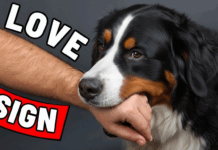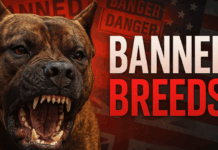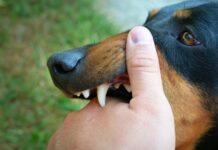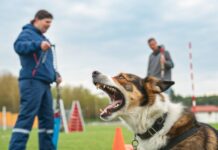Last Updated on June 25, 2024 by Dogs Vets
7 Dog Behaviors You Shouldn’t Ignore
When it comes to understanding our furry friends, there’s a lot more going on beneath the surface than meets the eye. Dogs, with their wagging tails and soulful eyes, have a myriad of ways to communicate with us.
As pet owners, it’s essential to be in tune with these behaviors to ensure our dogs are happy, healthy, and well-adjusted.
In this comprehensive guide, we’ll delve into seven crucial dog behaviors you need to take note of. Let’s embark on this enlightening journey together!
1. Tail Wagging: More Than Just Happiness
The Tale of the Tail
The tail is often considered a barometer of a dog’s emotional state. However, not all tail wags signify happiness. The position, speed, and direction of the wag can tell us a lot about what a dog is feeling.
Types of Tail Wags:
- High and Rapid Wagging: This usually indicates excitement or joy. Your dog is likely thrilled to see you or is anticipating something fun, like playtime.
- Low and Slow Wagging: This can be a sign of insecurity or submission. If the tail is tucked between the legs, it may indicate fear.
- Stiff Wagging: When a dog’s tail is stiff and wagging slowly, it could mean that they are feeling cautious or potentially threatened.
Understanding Your Dog’s Language
To better understand your dog’s tail wags, observe the context. Are they meeting a new person? Are they in a new environment? By considering these factors, you can better interpret their tail language and respond appropriately.
2. Barking: The Many Voices of Dogs

Decoding the Bark
Barking is one of the most common forms of communication in dogs. However, not all barks are created equal. Dogs bark for various reasons, and each type of bark serves a different purpose.
Types of Barks:
- Alert Barking: This is a quick, sharp bark intended to alert you to something unusual. It could be a stranger at the door or an unfamiliar sound.
- Demand Barking: This is when your dog is trying to get your attention or wants something specific, like food or a toy.
- Fearful Barking: This bark is often higher-pitched and accompanied by other signs of fear, such as trembling or cowering.
- Playful Barking: These barks are usually more repetitive and accompanied by a wagging tail and playful body language.
Responding to Barking
Understanding why your dog is barking is the first step in addressing it. If it’s demand barking, you might need to ignore it until they stop. For fearful barking, comforting and reassuring your dog can help alleviate their anxiety.
3. Chewing: A Window into Your Dog’s Mind
The Need to Chew
Chewing is a natural behavior for dogs. It helps keep their teeth clean, alleviates boredom, and can even reduce anxiety. However, excessive or destructive chewing can be problematic.
Common Reasons for Chewing:
- Teething: Puppies chew to relieve the discomfort of teething.
- Boredom: Dogs left alone for long periods may chew to entertain themselves.
- Anxiety: Dogs may chew to soothe themselves when they are anxious.
Managing Chewing Behavior
Providing appropriate chew toys and keeping personal items out of reach can help manage your dog’s chewing. Additionally, ensuring your dog gets plenty of physical and mental stimulation can reduce boredom-related chewing.
4. Digging: Understanding This Instinctive Behavior

Why Dogs Dig
Digging is another natural behavior rooted in a dog’s instincts. While it can be frustrating for owners who cherish their gardens, understanding why dogs dig can help in managing this behavior.
Reasons for Digging:
- Seeking Comfort: Dogs might dig to create a cool spot to lie down.
- Hunting Instincts: Some breeds have strong hunting instincts and dig to find small animals or insects.
- Boredom and Anxiety: Like chewing, digging can be a sign of boredom or anxiety.
Controlling Digging
To curb digging, provide a designated digging area for your dog or increase their physical activities to tire them out. If anxiety is the root cause, consider providing calming solutions or consulting a vet.
5. Jumping: When Enthusiasm Takes Over
Jumping Up on People
Jumping up is a common behavior, especially in young dogs. While it might seem cute at first, it can become problematic if not addressed early.
Why Dogs Jump:
- Greeting: Dogs often jump to greet people face-to-face.
- Excitement: When overly excited, dogs may jump to express their feelings.
- Attention-Seeking: Jumping can be a way to get your attention.
Training Against Jumping
Teaching your dog the “sit” command can be an effective way to curb jumping. Reward your dog when they sit calmly instead of jumping up. Consistency and patience are key.
6. Licking: A Multifaceted Behavior

Why Dogs Lick
Licking is a common dog behavior with various meanings. It’s essential to understand the context to determine why your dog is licking.
Reasons for Licking:
- Affection: Dogs often lick their owners to show affection.
- Grooming: Licking helps dogs clean themselves and can be a grooming behavior.
- Anxiety: Some dogs lick to soothe themselves when they are anxious.
- Medical Issues: Excessive licking can sometimes indicate an underlying medical issue, such as allergies or infections.
Managing Licking Behavior
If your dog’s licking becomes excessive, it’s essential to consult with a vet to rule out medical issues. For behavioral licking, providing distractions and engaging your dog in play can help.
7. Growling: A Warning Sign
Understanding Growling
Growling is often perceived as a negative behavior, but it’s an important form of communication. It serves as a warning and can prevent aggressive incidents if interpreted correctly.
Why Dogs Growl:
- Fear: Dogs may growl when they feel threatened or scared.
- Possessiveness: Some dogs growl to protect their food, toys, or territory.
- Pain: Dogs in pain may growl to signal discomfort.
Responding to Growling
Never punish a dog for growling, as this can suppress a critical warning signal. Instead, try to identify and address the underlying cause of the growl. If your dog growls out of fear or possessiveness, consider consulting a professional trainer.
Conclusion: Understanding and Responding to Dog Behaviors
Being attuned to your dog’s behaviors is crucial for a harmonious relationship. By understanding the reasons behind their actions, you can provide a supportive and nurturing environment that caters to their needs.
Remember, patience and consistency are vital in addressing and modifying any unwanted behaviors.
FAQs
Why does my dog wag its tail when it sees me?
Your dog wags its tail when it sees you as a sign of excitement and happiness. It’s their way of expressing joy and affection towards you.
How can I stop my dog from barking excessively?
To stop excessive barking, identify the cause and address it. Ensure your dog gets enough exercise and mental stimulation. Training commands like “quiet” can also help manage barking.
What are the best chew toys for dogs?
The best chew toys are durable, safe, and appropriate for your dog’s size and chewing strength. Toys like Kong, Nylabone, and rubber balls are popular choices.
Why does my dog dig holes in the yard?
Your dog may dig holes due to boredom, hunting instincts, or to create a cool spot to lie down. Providing ample exercise and a designated digging area can help reduce this behavior.
How can I stop my dog from jumping on guests?
Teach your dog the “sit” command and reward them for sitting calmly. Consistently enforce this behavior with guests to prevent jumping.
Is it normal for dogs to lick themselves excessively?
While some licking is normal, excessive licking can indicate allergies, infections, or anxiety. If your dog licks excessively, consult with a vet.
What should I do if my dog growls at me?
If your dog growls, do not punish them. Try to understand the cause of the growl, whether it’s fear, possessiveness, or pain, and address the underlying issue. Consulting a professional trainer can also be beneficial.
By understanding these key dog behaviors and how to respond to them, you’ll foster a deeper bond with your furry friend and ensure their well-being and happiness.
Remember, each dog is unique, and what works for one may not work for another. Patience, love, and understanding are the cornerstones of a happy and healthy relationship with your dog.
Reference:
- https://www.akc.org/expert-advice/training/dog-body-language/
- https://www.aspca.org/pet-care/dog-care/common-dog-behavior-issues
- https://www.petmd.com/dog/behavior/evr_dg_how-to-read-your-dogs-body-language
- https://www.bluecross.org.uk/pet-advice/how-understand-your-dogs-body-language
- https://www.cesarsway.com/dog-behavior/

















